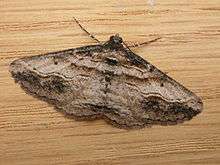Syneora
Syneora is a genus of moths in the family Geometridae erected by Alfred Jefferis Turner in 1917. All the species are found in Australia.[1]
| Syneora | |
|---|---|
 | |
| Syneora euboliaria | |
| Scientific classification | |
| Kingdom: | |
| Phylum: | |
| Class: | |
| Order: | |
| Family: | |
| Tribe: | |
| Genus: | Syneora Turner, 1917 |
Species
- Syneora cheleuta (Meyrick, 1892)
- Syneora leucanthes (Turner, 1947)
- Syneora excursaria (Walker, [1863])
- Syneora euboliaria (Walker, 1860)
- Syneora mundifera (Walker, 1860)
- Syneora silicaria (Guenée, 1857)
- Syneora praecisa (Turner, 1917)
- Syneora lithina (Warren, 1897)
- Syneora emmelodes (Turner, 1904)
- Syneora hemeropa (Meyrick, 1892)
- Syneora nigrilinea Goldfinch, 1944
- Syneora amphiclina (Meyrick, 1892)
- Syneora fractata (Walker, 1862)
- Syneora gypsochroa (Turner, 1947)
- Syneora adelphodes (Meyrick, 1892)
- Syneora cymatomita (Turner, 1947)
- Syneora mesochra (Turner, 1947)
- Syneora strixata (Walker, 1862)
- Syneora acclinis (Turner, 1947)
- Syneora odontosticha (Turner, 1947)
- Syneora acrotypa (Turner, 1917)
gollark: What? Biological problems are much easier than social ones. Bodies may be horribly convoluted poorly understood and highly stateful systems, but so is society, and at least you can do small-scale testing in biology.
gollark: Excellent.
gollark: Is this that sentient regex from a few days ago?
gollark: Just switch to radio telescopes.
gollark: This seems like not-particularly-meaningful word-association "reasoning".
References
- Savela, Markku. "Syneora Turner, 1917". Lepidoptera and Some Other Life Forms. Retrieved February 11, 2019.
- Pitkin, Brian & Jenkins, Paul. "Search results Family: Geometridae". Butterflies and Moths of the World. Natural History Museum, London.
This article is issued from Wikipedia. The text is licensed under Creative Commons - Attribution - Sharealike. Additional terms may apply for the media files.